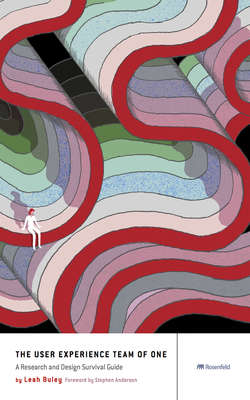Читать книгу The User Experience Team of One - Leah Buley - Страница 6
На сайте Литреса книга снята с продажи.
ОглавлениеFREQUENTLY ASKED QUESTIONS
What is a user experience team of one?
A UX team of one is someone who works in a situation where they are the key person driving a user-centered design philosophy. Certainly, if you are the only person in your company practicing (or aspiring to practice) user-centered design, you are a user experience team of one. However, even in organizations with multiple UX professionals, if you regularly work on a team where you are the only UX person, you are a UX team of one. Chapter 3 explains the kinds of challenges that UX teams of one commonly face, and explains what to do about them.
I’m a freelancer. Is this book for me?
The User Experience Team of One focuses primarily on people working in or with organizations. It is not explicitly geared toward freelancers, consultants, or contractors. Still, much of this book may be relevant for independents, insofar as they, too, must often work with the cross-functional teams of their clients. And for readers who are considering going out on their own, be sure to check out the section “Considering Going Independent?” in Chapter 4.
What’s different about life as a UX team of one?
If you are a UX team of one, you have these unique challenges:
• You feel like a jack of all trades, master of none. You do a variety of work: probably some design, some research, some writing, some testing, and some evangelism. You care about your work, and you want to do it well. But being a generalist, you may feel as if you are spread a bit thin. You may also wonder at times if you’re “doing it right.” Would a specialist’s level of knowledge make a tough design problem or difficult conversation easier to get through?
• You need to evangelize. You probably work with or for an organization that doesn’t yet “get it.” That is, they haven’t fully bought into the value and purpose of UX. Or, even if they do value user experience, they may not be in a position to fully fund and build a robust UX practice. Either way, that means that you’re constantly seeking to educate and influence.
• You’re learning on the job. You need to figure out how to do your work on your own. You may have discussion lists and professional communities that you can turn to for peer-to-peer advice, but in your day-to-day work, you often have to make an educated guess and then trust and defend your hunches as to the best next steps.
• You’re working with constrained resources. The biggest challenge for teams of one is time. There’s only one of you, and there’s a lot of work to be done.
• You’re charting your own course. No one in your organization has done this before. You’re figuring out your own career path, without a guide or a manual to follow.
What makes this role interesting is the dramatic tension between needing to inspire through expertise and trying to build your own expertise at the same time. This leads to a unique set of challenges that go well beyond simply trying to do good design. It makes skills like facilitation, flexibility, assertiveness, and persuasiveness central to the team of one’s toolkit. This interesting tension has practical considerations, as well as philosophical ones—and that simple fact is the inspiration for this book.
Chapters 2 and 3 explain the working conditions that a team of one often experiences, while Chapters 5 through 9 provide specific methods that are optimized for those working conditions.
Is this just an intro to a UX book?
Yes and no. This book is intended to be accessible to people who are just starting out in user experience, as well as seasoned practitioners. Chapter 1 provides an overview of user experience and can serve as a basic introduction to the field. However, the methods in Chapters 5 through 9 aren’t just typical UX methods. They have been chosen because they educate and involve others who may not be familiar with or supportive of user-centered design, while requiring less time and fewer resources.
